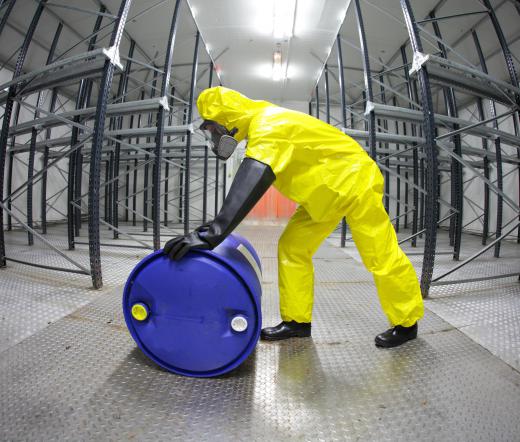Workplace hazardous materials are objects or substances present in the workplace that can pose a health risk to workers or to others who use a given area. The nature of these materials can vary substantially based on the nature of the workplace. Workplace hazardous materials in a biology lab or hospital commonly include chemical and medical waste, while hazardous materials at a construction site are more likely to exist in the form of construction and engineering materials. Hazardous materials generally need to be handled in a particular manner in order to avoid any damage to workers or property. They may, for example, need to be disposed of or transported in specialized containers.
Many different types of workplace hazardous materials need to be categorized and marked with special symbols in any given workplace per government or other regulatory agency specifications. Canada, for example, has the Workplace Hazardous Materials Information System (WHMIS), a system that indicates how different categories of hazardous wastes are to be marked. Different symbols exist to indicate materials that are, for example, toxic, radioactive, flammable, corrosive, or highly reactive. Different governments, professions, and organizations make use of different systems to indicate the dangers associated with workplace hazardous materials. The symbols used are usually easily understood whether or not one is completely familiar with the system; flammability, for example, is usually indicated by a flame-shaped symbol.

There are many special regulations that govern the storage, use, and disposal of workplace hazardous materials. These also tend to vary slightly based on the particular location of the workplace or nature of work. In medical fields, for example, it is important to properly dispose of medical wastes because they could, in many cases, cause harm to anyone who may later be exposed to them. Likewise, many different professions make use of flammable substances in significant quantities; it is important to ensure these are transported in highly-controlled environments to prevent fires. It is, in some legal systems, illegal to transport, store, or dispose of hazardous materials in an unsafe manner.

Though all of the regulations that control the use of workplace hazardous materials are generally effective, they are not flawless and incidents do occur. In such cases, there are generally established methods and safety mechanisms in place to counteract any harm or damage that the hazardous materials may cause. Labs that work with flammable or corrosive chemicals, for example, tend to have showers and eye wash stations in place to quickly wash the harmful substance off from a person's skin and eyes. There are also procedures for diluting or neutralizing spilled substances that are particularly harmful when highly concentrated.
